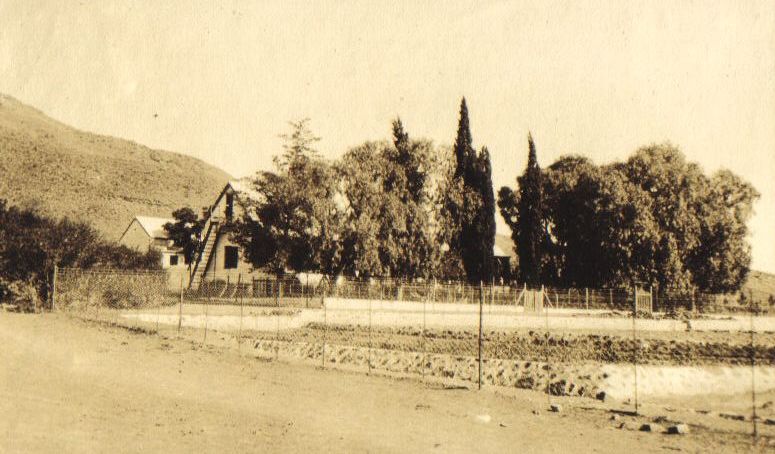Lil Molteno’s Farm School at Nelspoort
By Lil Molteno (nee Sandeman)
Source: Chronicle of the Family, Vol. 6, No. 2, August 1918
Introduction
In the early 20th century, there was little or no schooling for the children of African and Coloured workers on the white-owned farms of the Platteland. Illiteracy was near universal. But Lil Molteno, Wallace’s wife, was a Scotswoman and valued education. Once settled on the Karoo, first at Kamferskraal, and eventually at the main farm Nelspoort, she decided to set up a farm school. In late 1917, and after a good deal of difficulty, she obtained a grant from the Government – subject to a list of conditions — for a school for the Coloured children of the workers on this and the neighbouring farms. The description below is of that school. A few years later, she started an even more ambitious project – to organise a school near Nelspoort Station, presumably in the hope that it would be accessible to the children living in the vicinity (we have to remember that distances on the semi-desert Karoo are huge, which limits how far children can be expected to walk to school).

The farmhouse at Nelspoort, c. 1914 — where Lil and Wallace Molteno lived when they moved from Kamferskraal
father, Sir John Charles Molteno’s, estate. But getting this permission proved not entirely easy! In April 1923, she wrote to Percy Molteno, and presumably to the other members of the family, asking if he would be ‘willing to give, or sell, me a site for a Mission School on the farm near Nelspoort Station’. Ted Molteno, the eldest boy by Sir John’s last wife, Minnie (now Lady) Molteno, tried however to persuade his mother not to consent. His opposition was overcome and the family gave permission.
Robert Molteno
March 2012
I wish you could all see Lil’s mission school as I first saw it. We started out from the Nelspoort farm one sunny morning in July, while the ice still clung to the edges of the sluits [sloots or water furrows] , and walked across the three miles to Mimosa Grove.

The Karoo at Kamferskraal today, looking in the direction of Nelspoort (to right of the mountain)
We walked through the solitude and spaciousness and beauty of the Karoo world , past the dam, on through the ridge and over a foot-bridge and then suddenly came out upon the Mimosa Grove farm-house to find ‘teacher’ giving the children their gymnastic drill out in the open before the school-house door.
‘Teacher’s’ incisive voice rang out ‘Arms, forward, bend!’ ‘Arms, upwards, stretch!’ ‘Bodies, sideways, twist!’ And seventeen animated bodies obeyed with an alacrity that spoke well for ‘teacher’s’ discipline though seventeen pairs of eyes strayed with keen interest in our direction. And I wish you could have seen the children themselves, from the tiny woolly-headed girl who danced with eyes and toes through the motions, to the tall lanky boy whose arms and legs moved in all sorts of angles and directions. But, there they were, seventeen of them, not only alive with proud interest in their pursuit, but gleaming in cleanliness of skin and clad in whole and clean clothes. To be sure there was a kind of pathos about some of their clothes, as, for example, in the lanky boy’s coat with sleeves like drainpipes sewed onto shoulders that came down many inches on the arms and with fronts fastened tight across the chest with pins (of course, Lil speedily furnished buttons to help that). But even this coat showed a mother’s pride and care and when one knew that some of these children had up to now run wild on the veld, one realised what the school had done for them and their families in one short term of twelve weeks.
Then too, I wish you could all have attended the school concert at the end of the September quarter, in all the lamp-lit grandeur of Wallace’s shearing-house. Here, there were refreshments served by proud and interested Mission-school parents and purchased by themselves as well, all for the benefit of the school. There was a programme of some thirty numbers, containing songs, recitations, dialogues etc. not only in the two languages [English and Dutch] but having all the day-school children, the parents, big sisters and brothers of the evening classes and even ‘teacher’ herself as participants. (There was also a unique plan of having all the encores at the end with an extra charge for each!) Lil and Donald and Aimee as patrons occupied seats of honour near the platform and Pal (the dog) took a prominent part, seeking his friend, Lil’s cook. If you could have seen and heard all we did that evening you would have agreed with us that it was hard to realise this school was but six months old.
However , if it has existed in material form but six months, it has been working in Lil’s mind much longer than that. From the time she first came to Kamfer’s Kraal she seems to have been worrying about the coloured children, though not until they moved to the Nelspoort Farm could she carry out any of her plans. And then it took months to find out all the things to be done to start the school and still more months to do them. There was the Department of Education to interest in giving the grant to make the school possible; Mr Wilmot’s permission to obtain to have it at Mimosa Grove — the vantage point for the two farms; the parents to stir up to a sufficient eagerness for Education to furnish both children and fees; further plans to devise so that the school should be self-sustaining and not pauperising; the teacher to select and initiate, and all the final details for starting and carrying on the enterprise. And now even, when Lil works out her balance sheet for the Department and finds that the whole plan works, she has no assurance that the school will be, as she hopes, a permanency for the Department’s continuance of its grant rests on the having of an average attendance of twenty, and the maximum attendance of twenty-eight, only promises to fulfil this demand when parents and children have been educated to regularity.
In the months that have already passed there have been many experiences, some amusing and some quite otherwise, Of the former, there stands out the day when Mr Wilmot, having forgotten all about the school, came along and seeing a number of children playing around Mimosa Grove (at their recess) sent them off to drive some straying sheep. And there was no more school that morning. But the trying sort of thing to bear is when ‘unbelievers’ in any sort of work for the coloured people come along and rail at Lil and tell her that she is sowing the seeds of Bolshevism among them. Of course. Those of us who believe in the possibility of making the coloured people into a self-respecting moral, decent race and who see in Bolshevism the natural outcome of a discontented , immoral ignorance, these railings count for nothing, but we readily admit that in the midst of the inevitable discouragements of running a Mission School they must be very hard to bear.
However, in the meantime, the school goes on. Day by day, the children learn to read and write in English and Dutch, to sing hymns and songs in both languages, to recite psalms and Bible verses, to sew and play, to keep themselves, their work and their school room neat and tidy, to obey their energetic Lovedale ‘teacher’ in mind and body. Canon Moore visits them and finds their progress satisfactory (and unusual). Lil stands behind it all and supplies the extras, ranging all the way from soap and Jeyes fluid to cheer and encouragement, and cake and friendliness. And the rest of us take comfort in the knowledge that on at least one Karoo farm the coloured children no longer run wild on the veldt with half-naked bodies and wholly tattered morals, but get some of the better things that life should hold for all children of whatever race or colour.
Explanatory Notes
- Nelspoort was the main farm in the cluster of farms the family owned. Wallace and Lil Molteno moved there from Kamferskraal in about 1918.
- Mr Wilmot was a very close friend of Wallace; and at this stage was farming the neighbouring farm of Mimosa Grove. He later farmed about 30 miles away on the Nieuveld.
- Donald and Aimee Molteno, Wallace and Lil’s elder children.
- Lovedale was a remarkable educational institute at Alice in the Eastern Cape where many African and Coloured, and even a handful of White, South Africans received their education in the 19th and 20th centuries.
